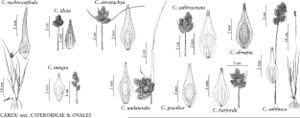Difference between revisions of "Carex harfordii"
Bull. Torrey Bot. Club 43: 615. 1917.
FNA>Volume Importer |
imported>Volume Importer |
||
| (6 intermediate revisions by 2 users not shown) | |||
| Line 6: | Line 6: | ||
|place=43: 615. 1917 | |place=43: 615. 1917 | ||
|year=1917 | |year=1917 | ||
| + | }} | ||
| + | |special_status={{Treatment/ID/Special_status | ||
| + | |code=F | ||
| + | |label=Illustrated | ||
| + | }}{{Treatment/ID/Special_status | ||
| + | |code=E | ||
| + | |label=Endemic | ||
}} | }} | ||
|basionyms= | |basionyms= | ||
| Line 11: | Line 18: | ||
|name=Carex montereyensis | |name=Carex montereyensis | ||
|authority=Mackenzie | |authority=Mackenzie | ||
| + | |rank=species | ||
}} | }} | ||
|hierarchy=Cyperaceae;Carex;Carex sect. Ovales;Carex harfordii | |hierarchy=Cyperaceae;Carex;Carex sect. Ovales;Carex harfordii | ||
| Line 34: | Line 42: | ||
-->{{#Taxon: | -->{{#Taxon: | ||
name=Carex harfordii | name=Carex harfordii | ||
| − | |||
|authority=Mackenzie | |authority=Mackenzie | ||
|rank=species | |rank=species | ||
| Line 48: | Line 55: | ||
|publication title=Bull. Torrey Bot. Club | |publication title=Bull. Torrey Bot. Club | ||
|publication year=1917 | |publication year=1917 | ||
| − | |special status= | + | |special status=Illustrated;Endemic |
| − | |source xml=https:// | + | |source xml=https://bitbucket.org/aafc-mbb/fna-data-curation/src/2e0870ddd59836b60bcf96646a41e87ea5a5943a/coarse_grained_fna_xml/V23/V23_601.xml |
|genus=Carex | |genus=Carex | ||
|section=Carex sect. Ovales | |section=Carex sect. Ovales | ||
Latest revision as of 20:41, 5 November 2020
Plants densely cespitose. Culms sometimes lax, (29–)50–135 cm. Leaves: sheaths adaxially usually brown or gold tinged near summits, summits U-shaped, prolonged to 4 mm beyond collar; distal ligules 2–7.5 mm; blades 2–4 per fertile culm, 15–35 cm × (1.8–)2–5(–9.9) mm. Inflorescences dense, headlike, brown to gold, 1.1–4 cm × 7–20 mm; proximal internode 1.5–2.5 mm; 2d internode 1–2.5 mm, these 2 internodes collectively less than 1/3 as long as inflorescences; proximal bracts usually bristlelike, occasionally leaflike, much longer than inflorescences. Spikes (4–)6–17, densely aggregated, usually individually indistinct, broadly ovoid to ovoid, 4.7–9(–12) × 3.7–7.6 mm, appearing coarse-textured, base rounded to acute, apex truncate to acute. Pistillate scales pale green or straw colored to brown or reddish, often with green to straw colored midstripe, ovate to broadly ovate, 2.2–4.7 mm, shorter to slightly longer than perigynia, less than or equal in width, margin white, 0–0.2 mm wide, apex obtuse to awned. Perigynia ascending, green or straw colored to light or coppery brown, conspicuously 4–9-veined abaxially, conspicuous 0–4(–9)-veined adaxially, veins thin, reaching top of achene, ovate to broadly ovate, plano-convex or biconvex, (2.6–)3.3–4(–4.6) × (1.2–)1.4–1.6(–2) mm, 0.6–0.7 mm thick, 2.1–2.7 times as long as wide, margin flat, including wing 0.1–0.3(–0.4) mm wide, ciliate-serrulate on distal body, often with metallic sheen; beak brown or gold at tip, cylindric, unwinged, abaxial suture inconspicuous, distance from beak tip to achene 1.2–1.8 mm, ± entire for (0–)0.3–0.7 mm. Achenes usually ovate to broadly ovate, (1.3–)1.5–1.9 × (0.9–)1–1.2(–1.4) mm, 0.5–0.7 mm thick.
Phenology: Fruiting spring–summer.
Habitat: Moist to wet or boggy marshes, open areas near the coast
Elevation: 0–600 m
Discussion
Selected References
None.

